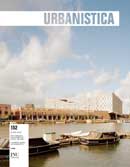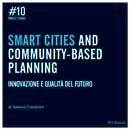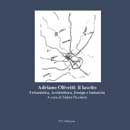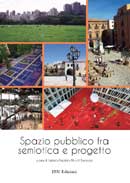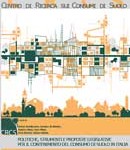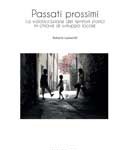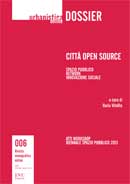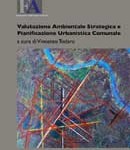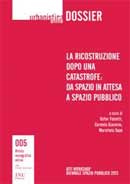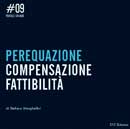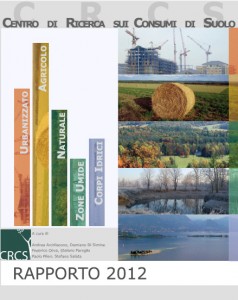Il paper del prossimo Congresso dell’INU alla Biennale degli Urbanisti a Cascais
 19/09/2013
19/09/2013
Recently, INU introduced the custom of broadening the boundaries of its reflections to actors and concerned citizens that do no normally frequent its annual congresses. On the occasion of the October XXVIII congress, this effort is taking an international dimension. Accordingly, the English version of INU’s position paper for the Congress has made its debut at the X Biennial of European Towns and Town Planners, held in Cascais, Portugal.
INU invites critical comments to its position paper from “foreign” audiences. These comments can be addressed to segreteriapresidenza@inu.it copy pietro.garau@inu.it. We hope to be able to start a rich and vivacious conversation on the themes developed in this paper
POSITION PAPER
Three themes for the National Congress
To think of cities as the country’s engines of development means, first of all, to think once more in terms of development (or growth), albeit in a model of development (or growth) different from those conceived in the past: our unmet needs -work, housing, mobility, services – are still too numerous to let us think in a different direction, determined as it may be by economic and societal transformations that this prolonged crisis seems bent on crystallizing. Thinking of cities as engines of development means freeing the cities’ capacity they possess to produce public and private wealth. This capacity appears mute today , but it can be unleashed through a radical change in the way we see cities and consequently in the way we operate in them, re-discussing most of the analytical and operational certainties and paradigms we built iup to now, including the very recent past. It means choosing urban regeneration as the central focus around which to redefine a new strategy of action to create, both in the medium and in the long term, a new model of public intervention and programming of resources.
A transition from a perspective of transformation and upgrading to one of urban re-generation means, in fact, on one hand, to put into play many more urban and territorial components. On the other hand, such transition means putting into play all the resources of urban economies, and using them to address needs of improved housing and services, of filling gaps of public -space provision and the improvement and better enjoyment of existing ones, of the development of the economy and job creation for growing urban populations. This approach aims first of all at freeing the resources cities already have, taking advantage of their endogenous potentialities and starting from a radical reform of local fiscal arrangements. At the same time, this will also require an intervention at the national and regional level consisting in an “exogenous” commitment to “policies for the cities”, to promote and finance interventions that cannot be sustained by local authorities such as those related to mobility, public transport and energy infrastructure. A first signal of such an intervention already surfaced in 2012 with the “Piano Citta’ ”, a commitment that gained further focus with the creation of the Interministerial Committee for Urban Policies (CIPU) early this year. These initiatives must be sustained and adequately developed starting from a National Urban Agenda capable of enabling municipal authorities to be directly involved in the elaboration of development strategies linked to the 2014-2020 cohesion policies, and of developing integrated actions in the area of sustainable urban development.
Thus, while these notes argue that the planning strategies of cities have to change radically, we cannot abandon our efforts to demand a new policy for cities on the part of central government. While such a policy will be able to rely, in the future, on all necessary resources once ongoing deficit and debt reforms are completed, the understanding is that even now central-government support will have to supplement the cities’ own resources to create a new development scenario. In turn, such development scenario will have to be entirely different from those designed in the past. Only this way, putting in play their own energies and with the support of a national agenda, will cities be able to express those typical capacities for both competitiveness and for cohesion that stem from their own unique resources.
The great changes in cities
These first few years of this new century are characterized primarily by the great changes of cities, their territories and the society that populates them. Looking at European cities and at Italian cities in particular, we are witnessing a first and ever more evident change in terms of urban settlement systems: the explosion of the city in its hinterland and the surfacing of a new city – metropolitanized or post-metropolitan – radically different from the vastly regular and continuous growth process in metropolitan peripheries that characterized first the industrial city and then the modern city, and that planning strived to govern through regulatory instruments within a general framework of rational zoning. The contemporary city, where a majority (two-thirds) of Italy’s population lives, is by now largely porous and discontinuous, made up of built, partially-built and open systems, with a great number of sites that in the past we would have considered partially transformable (abandoned and/or underutilized sites, various urban vacuums). Together, such areas offer a supply far in excess of any reasonable level of demand for development, be it of a public, or – in particular – of a private nature. This discrepancy, incidentally, also poses the problem of temporary uses to prevent urban decay.
The contemporary city is also characterized by a serious level of non-sustainability caused by the continuous erosion of environmental resources required by their metabolism, by the polluting and congestion effects of mobility systems still too dependent from private motorized transport, by the enormous waste of energy due to an aged building stock, and by land use practices indifferent to such predicaments. We are dealing, therefore, with a city that has to be tackled for what it is, realizing that it will not be possible to transform it as we imagined in the case of the settlement models of the past, in the form of a continuum of built up and open urban spaces juxtaposed with extra-urban space; that we shall not be able to densify it by filling in all its porosities and discontinuities; that we shall have to treat it bearing in mind its complex, molecular essence made up of urban spaces of different density and land use patterns, of natural and quasi-natural spaces, where primary urban settlement situations can coexist with rural ones.
A second change, more recent and made more evident by the crisis we are still going through today, has to do with the urban economy: the collapse of the real estate sector due to the impoverishment of the population and the employment crisis, the credit crunch, but also to the overproduction of building stock of the last decades not matching a strong, but qualitatively different housing demand. At the same time, the very productive capacity of cities has subsided, partly because of the overall reduction of employment (the crisis caused the loss of 1.3 million jobs so far, a 9% reduction of family income, and a three-point reduction of GDP) which is, in turn, closely linked to the building and infrastructure sector and therefore largely of an urban nature. However, the most evident transformation has to do with the already mentioned growing gap between the increasing supply of amount of potentially transformable areas and the shrinking demand of the real estate industry. This gap, incidentally, will not be breached once -and if- the crisis ends, while it will inevitably change the mechanisms determining the formation and accumulation of unearned land value increment as well as real estate values as a whole.
More generally, the competitiveness of cities has declined, not only because of the crisis, but also because of outdated current governance and decisional models, which do not allow them to make timely and adequate decisions thus preventing the valorization of all available resources and opportunities.
Moreover, cities, like all local governments, are suffering from the severe reduction of public budgets operated at the central level, compunded by the lack of a rational and efficient local tax system. This raises serious doubts on their ability to ensure adequate services and infrastructure maintenance, as well as to ensure the needed increase of “fixed urban capital”. In view of these problems, the ongoing reform of the most important local property tax (IMU) must ensure that the overall income remains at least at the same levels as the ones prefigured by the last budget.
The third great change affecting cities is an environmental one. A reference has already been made to the non-sustainability of the continuous erosion of fundamental environmental resources including non-renewable ones like land, threatened by the present development model, and to the need to pursue a settlement model based on a drastic reduction of land consumption and the re-naturalization of many unbuilt areas within the city, whose development does not appear feasible in view of expected trends. The excessive consumption of agricultural land and natural sites is not simply a landscape issue, as it concerns deeply rooted ecological problems such as the relentless paving of urban spaces, the loss of natural cover and the consequent reduction of the natural regeneration capacity of vital environmental resources such as air and water; it is also a significant cause of ongoing climate change and hence of the frequent occurrence of extreme meteorological events that pose growing threats to urbanized areas, already fragile because of haphazard development. Of course, this problematique also includes landscape and cultural heritage issues, too often considered lateral viz-a-viz mainstream planning.
Theme 1. Urban Regeneration as Resilience
In view of the great changes briefly described above, policies for cities, and in particular planning and environmental policies, must also change radically. The reason is that the paradigms that guided, or attempted to guide, urban expansion first and urban transformation later, are no longer valid. This new approach will necessarily take its departure from present urbanization , economic and environmental conditions of cities, and apply an adaptive strategy suited to specific contexts, aimed at reaching a new ecological state capable of achieving a balance between the availability of fundamental environmental resources and a sustainable growth path. This goes beyond the mere promotion of new urban redevelopment interventions and their wide diffusion, as it is meant to “re-discuss” all portions of the city whose functioning shows a deficit between available resources and those required for sustainable growth – counting among such resources, in addition to fundamental environmental resources, also energy sources. Such a strategy can, therefore, be defined as one of urban regeneration as resilience.
From a planning point of view, such an approach contemplates the following:
• The exclusion or radical containment of any new consumption of open space that does not perform a relevant function of environmental regeneration; not only, therefore, peri-urban and agricultural land, but also unbuilt land within the city (corresponding to the “porosities” and “discontinuities” previously referred to);
• The re-naturalization of surface hydrographic courses artificially surfaced during the last century and still being paved, and the increase of vegetal cover over permeable open spaces, publicly and privately owned, be they urban or quasi-natural, within the urban fabric – both required to contribute to territorial safety and stability;
• The selection of new transformations in built-up areas (areas to be redeveloped, textures to be restored), with modalities (indices, parameters) capable of enabling environmental regeneration;
• The regeneration of the many portions of built-up areas poorly equipped and underperforming from an environmental and energy-efficiency point of view, through interventions of substitution and/or radical restructuring;
• The regeneration, through functional integration and densification, of specialized facilities at the meta-local scale built for justified decentralization purposes but no longer sustainable from a functional and financial point of view;
• the maintenance, improvement and renovation of urban infrastructure, starting from the existing stock, previously neglected in the past in favour of major works often suspended for lack of funds. This includes, in addition to transport infrastructure, all water and sanitation networks, some of which perform a fundamental role in terms of urban sustainability – such as sewers in connection to surface and aquifer water systems and water supply distribution systems connected to uses of non-potable water; energy distribution networks integrated with renewable energy supply; and networks for the collection and disposal of solid waste.
Theme 2. What Form of Plan and the New Tasks of Planning
Contrary to what a superficial reading of present growth trends may suggest, the profound changes currently affecting cities and their hinterlands assign to planning and its fundamental tool for action – the plan – an even wider and more important role than in the past phases of urban growth and transformation. The reason is that we need greater ability both in interpreting ongoing phenomena with an eye to “anticipating the future”, and in
searching for the most appropriate solutions to govern an extremely difficult situation, characterized by a generalized scarcity of resources.
In the recent past, INU often underlined the necessity of simplifying and innovating our planning system. Such a request will continue to be addressed both to national and regional legislators, in partnership with the other Associations that supported it. This is, however, simply a necessary but not sufficient step on the road to reform. Simplifying an inherently complex matter is not easy and it cannot be reduced to a slogan; however, what could be simplified as a starting point are the procedures for preparing and adopting plans – and in fact, such measures are reflected in the most recent planning legislation at the regional level. But the most relevant and effective simplification, capable of modifying our planning system in a significant way, is co-planning, i.e. the involvement -ab initio and throughout the entire process – of all authorities and agencies with responsibilities and competences in territorial governance, thus avoiding the sequels of frequent post-facto opinions issued after a plan’s adoption that complicate and slow down the whole process. This is another historic demand of INU which, in fact, has been echoed in regional reforms – particularly with the introduction of planning conferences. However, the participation of state entities ( those, for example, in charge of the protection of historical and artistic heritage and river basin authorities), is governed by state regulations and has occurred so far on a purely voluntary basis, thus invalidating the very spirit of this new mechanism.
More generally, INU must reconsider with more detachment the whole experience of reformist regional laws adopted since 1995 and successively post- 2001, after the reform of Title V of the Italian Constitution [regulating the respective roles and competences of statal and regional entities], that we grew accustomed to consider the “planning reform”. This “reform” was, on the contrary, a half completed one, as not all regional legislatures adequately developed the “INU model” consisting, in essence, of a new structural plan of a non-prescriptive, programmatic nature and bearer of a strategic vision; an operational plan, prescriptive and legally binding but of limited validity, with the automatic expiry of development permits after a five-year period; and finally a planning code, i.e. rules and regulations for the built-up city. Some regions, however, have adopted these new models without changing the juridical nature of plans; others simply confirmed the regulative nature of the old “Piano Regolatore Generale” (PRG), totally ineffectual in the face of ongoing territorial transformations. Thus, in many cases we register a return to the past, with the old regulatory instruments masqueraded as structural plans. A significant example is the recent case of the Piedmont region, which legislated numerous albeit insignificant modifications to the glorious “Legge Astengo” while abandoning the path of innovation and reform. Innovative pieces of legislation, such as those proposed by the Friuli-Venezia Giulia and Marche regions, are few. Even the new implementation mechanism proposed by INU – equalization, compensation, new discipline of building rights – albeit adopted almost everywhere, lacks a codification at the national level capable of correcting distortions such as an excessive use of land caused by the calculation of equalization and compensation rights based on allowed construction surface and not on the actual value of potential transformation – a correction that would, moreover, be better suited to the present situation.
The emerging picture is, therefore, one of an incomplete reform and of a “plannning federalism” oscillating between the improbable and the ridiculous, with scores of different denominations for the same thing and many juridical contradictions which weakened regional legislation once subject to jurisprudential review. INU and its regional chapters, therefore, should consider this “incomplete reform” for what it is, with as much disciplinary diligence as required but also with the necessary scientific rigor, without any special benevolence for the reform it inspired in 1995. Above all, the most flagrant absence is the absence of the State and of a Law on the Fundamental Principles for Territorial Governance, an indispensable step to recompose the maddened pieces of the regional puzzle, that INU must continue to demand – without necessarily considering this the centerpiece of its advocacy. On the other hand, there is reason for hope. Recently, a legislative proposal, Norms for the Containment of Land Consumption and Urban Regeneration, has been presented to Parliament. This proposal contains many positive features and would, in fact, address many aspects introduced by the above mentioned Law of Principles, with the exception of the fundamental points of genuine co-planning procedures and of the new forms of the plan. This instrument – the plan – once thoroughly innovated as repeatedly pointed out by INU, appears indispensable for governing ongoing changes within cities and their territories. As to the containment of land consumption, the legislative proposal recalled above is not the only one on the floor: in addition to others from different parliamentary groups, there is one formulated by the present government itself within the so-called “Decreto del Fare” . All of them constitute proof that this topic now resonates with public opinion and give reason for hope in a rapid and adequate legislative solution.
As to the juridical efficacy of plans – a topic that cannot be addressed in contradictory ways at the regional level – the regulatory and conforming nature of real property must be abandoned decisively and once and for all. The structural plan model must be implemented with greater coherence by introducing a key innovation capable of radically changing our way of planning: giving up any “synoptic representation of a presumed end-of-state” in favour of programmatic documents dispensing with the task of detailing all possible transformations – as is the case today even when at issue are not objective situations of indisputable public interest. More precisely, this would imply a preliminary selection within the many areas capable of transformation, also taking into account the relationship mentioned previously between supply and effective demand; and consequently, operationalizing only those transformations whose time has come and which are supported by a consensus at the community level.
Building a structural plan means articulating essential provisions in relation to the three fundamental systems – infrastructure, environment and settlements. Such provisions are of a programmatic nature – given the “non-conforming” juridical nature of this instrument – save for those deriving from “recognized boundaries” . These boundaries, that can stem from national and regional norms or from projects, including local ones, defined in every aspect, have taken the name of “invariables”, given their long-term character and their concern for entire categories of goods or territories. Defining such “invariables” is also a task of the technical wisdom of planners and of other specialists called upon to design various aspects of a plan: an important wisdom, built over time, although all too often underrated by politicians – not without fault on our part. Such invariables are to be defended as non-negotiable, by virtue of the technical worthiness of their identification and the connected full responsibility for key choices that must be attributed to planners and their consultants.
The structural form will have to be accompanied by a new scale of planning to take into account the diffusion of metropolitanization, while the municipal scale will be feasible only in those special cases characterized by the absence of the new post-metropolitan dimension of the city. We must also keep in mind that in 2014, as a consequence of Law no.135 of 2012, ten Metropolitan Cities will be instituted to replace present provinces, while the process of abolishing the other remaining provinces will continue. Obviously, the only form of plan feasible for the Metropolitan Cities will be the structural plan. And the same will have to apply to all other territorial coalescences produced by metropolitanization, thus elevating structural and strategic planning to the multi-municipal level.
The new general strategy of urban regeneration that we proposed earlier to tackle the challenges of the contemporary city also implies a thorough revision of the planning techniques employed so far. This is an area where INU – by virtue of its history, its social structure, its cultural and disciplinary imprinting – is uniquely suited to claim its own, including at the professional training level. Following below are some of the most relevant aspects of urban regeneration requiring an evolution of operational planning techniques:
• The regeneration of the existing building stock , be it through a conservative or a substitutive approach. In the first case, the hypothesis is to improve the habitability and energy efficiency performances of the existing stock, keeping in place residents but adapting floor areas to their actual needs;
• The regeneration of urban brownfields (decommissioned, abandoned and interstitial sites). This topic is not new: however, past interventions have been characterized by a strong component of speculation and very high value increment expectations leading in turn to densities and utilizations unsuited for the urban fabric they were part of; therefore, solutions must be sought coupling environmental regeneration with the provision of additional services and public spaces for the surrounding areas;
• The regeneration of public spaces, by inserting compatible functions (commercial, high-end, services, parks and ecological greens); this aspect, already widely practiced, requires a search for the economic balance needed to make interventions feasible;
• Land uses for energy waste containment, with planning solutions responding to appropriate design techniques (densities, heights, settlement typologies,ecological features, and so on) thus determining positive energy behaviours at the settlement level, and reducing energy requirements;
• The revision of existing planning standards, necessary both as a result of a sustainable, non-car dependent mobility, and of adequate urban ecological networks connected with territorial ones. In the first instance, the ratio of parking spaces should be reduced in the presence of alternative transport systems or in areas closed to vehicular circulation. In the second instance, the supply of “public space” will have to include all open spaces, public and private, that enable the continuity of ecological networks, and that will have to be considered in the calculations of public space standards. At any rate, the updating of the 1968 Decree [on planning standards], issued at a time when urban, environmental and above all socio-economic conditions were totally different from those of today, is an objective necessity.
Finally, the new way of planning must put in place from the very beginning a path of designing and knowing the city, with the plan becoming not just the place where rights are granted and transformations outlined, but also a catalyst for the ideas that must, from the start, guide political decisions. In sum, we must rediscover and re-interpret integrated urban policies and rapidly find answers totally different from the traditional ones, precisely because they are bound to be coherent with the new urban condition acquiring its contours from the irreversible effects of the crisis.
Theme 3. Resources for Territorial Governance, the Public City and Urban Welfare
This theme was the focus of the debate at the previous twenty-seventh Congress in Livorno. However, despite the importance and interest of these topics, we have not registered theoretical advances on our part, neither elsewhere, nor in the planning practices, however reduced and influenced by the crisis, that emerged since then. This has also been influenced, at the national and legislative level, by policies entirely devoted to capturing resources and subtracting them across the board from cities, regarded as easy targets for spending cuts rather than potential laboratories for growth.
In any event, also because of the scenarios the crisis ushered in during these last few years with a further reduction of the resources needed, it becomes more and more clear that any future plan will have to confront the issue of available or obtainable resources, and avoid (or postpone) any provision whose implementation is not backed by real resources. This will also have to be the “style” of future planning actions, inspired by sobriety or, if you will, by a new austerity, so as to guarantee realism and common purpose to planning choices.
Among the possible economic resources to rely on one must always consider the unearned increment on land, a “wealth” produced by the city and its territory and up to now almost exclusively privatized. The option formulated by the twenty-seventh Congress of INU of a social redistribution of the unearned value increments of land, albeit not developed further since then, has drawn support from many – from entrepreneurs to unions, from the National Association of Developers (ANCE) to professional guilds. After all, hitting rent as a non-productive factor has always been a principle of liberal economics, despite the fact that in Italy, after the attempted “Sullo Planning Reform”, the same principle has never been upheld save for a partial measure in the “Legge Bucalossi” of 1977 with the introduction of the principle of due payment in exchange for building permits. This does not happen in other European countries explicitly embracing liberalism such as the Swiss Confederation, where a federal law confirmed by popular referendum enables each Canton to impose a levy of between 30 and 50% on the increments in real property values produced by a formal building provision (such as a zoning decision) that (quote) “increases significantly…without any effort on the part of the owner”(unquote). The proceeds from such levy flow into a municipal fund to compensate land owners whose previous building rights are removed by a new planning decision (“dezoning”), or to create public spaces like squares and parks. It is a choice inspired by a stringent and clear logic, that INU considers an example to study in depth, despite the differences between our two countries in terms of land and planning legislation, in addition to the different weight of rent (the “real estate surplus value”) (accordingly, the Swiss law in its definitive version is published on INU’s web site.
While a law of this kind should be, in fact, promoted in Italy as well in order to access the main potential resource to finance the “public city” (public space, local public works, and social housing), we should not underestimate the variations in unearned income accumulation in our cities and the related differences in financial margins allowed by this redistribution hypothesis. In addition, the crisis, taking into account the enormous dimensions of the built up stock and the high levels of home ownership, has profoundly modified the Italian real estate market to a point where many experts think it impossible to go back, even in the long run, to previous real estate values and to a market as rich and dynamic as the one that had developed up to the beginning of the crisis itself. That market had allowed for the experimentation of forms of partial social redistribution of rent through the realization of public works (“qualitative” standards) or via the imposition of “extraordinary contributions”.
At any rate, the need to mobilize new resources for the “public city” suggests we should keep moving in this direction, evidencing even more clearly the feasibility of redistributing urban rent through new fiscal arrangements.
Similarly, the possibility to capture significant portions of unearned income including the realization of public projects, which has been experimented by some local plans and incorporated in some regional laws, will have to be the object of national legislation. Such a provision should be applied in all cases where real estate markets show a a particular buoyancy, in addition to unearned income capture through fiscal measures.
The positive contribution that new taxation measures can offer is to help implement ambitious policies that planning by itself cannot resolve. Such is the case of the containment of land consumption and urban regeneration, strategies that demand extra resources in addition to those required for standard implementation practices.
More generally, the issue of fiscality, and of resource generation at the local level in particular, must become an organic component of plan implementation and in the mobilization of the resources required by the “public city”, keeping in mind that not all the needs of territorial governance and therefore of planning provisions can be funded this way. This is the case of the financing of major infrastructure , of hydrogeological safety and of seismic protection which do belong to the sphere of structural planning but must be financed at the central level. However, the high costs borne every year in remedial interventions after major damages to our territory and our fixed capital stock suggest that preventive measures of this kind should be the concern of prudent budgetary policies. A few norms introduced in 2012 by the then “technical government” do point in this direction.
An issue that deserves separate treatment is Edilizia Residenziale Sociale (social housing). Over the past few years, INU has treated this issue within the sphere of the “public city”. Previously, however, social housing had been funded directly by the State, because it was considered a fundamental right just like education and justice. While state support for subsidized housing declined considerably, public funding for Edilizia sovvenzionata (public housing units assigned for rental to needy households at social price) ceased altogether more than fifteen years ago. Such funding stopped not only for new construction, but also for the maintenance of existing public housing units, thus determining the culpable alienation of part of the public housing stock; while public housing needs have certainly not disappeared (such needs are estimated today in the range of 500,000 housing units). Faced with such situation, which affects in particular three social groups (youth with precarious jobs, single aged people, and migrants), sheer necessity suggested experimenting with new forms of social housing, an approach imported from other countries. As we know, this involves generally public-private negotiation (Inclusionary Housing) to promote the construction of price-controlled housing, both for rental and for sale; therefore, a kind of housing aimed at solvent clients (“affordable housing”, defined in Italy as Edilizia convenzionata e agevolata). This kind of housing can also produce a minor portion of rental housing for economically weaker households (social housing). In Italy, however, this term is used to include a whole range of housing solutions, including those directed at higher-income recipients.
Although this kind of social housing has registered positive experiences in our country, our overall structural conditions exclude the possibility of it becoming the definitive solution of the problem. The extremely high ratio of owner-occupiers (double that of the US and of the UK) and the size of non solvent demand, coupled with the virtual paralysis of housing markets and the heavy restrictions on borrowing enacted after the crisis, make this approach unfeasible and force alternative paths. One of them was suggested by Campos Venuti in a short essay which is also available on the INU website www.inu.it (“Patrimonio edilizio: Rigenerazione vs Espansione”). This essay recommends to intervene on the relevant portion of the nation’s housing stock (more than 30%) of low efficiency, high consumption of energy, and of a size inadequate to present needs of average households. What is proposed is a regeneration strategy capable of throwing on the rental market a stock of housing units far superior to current demand without increasing the stock itslef in terms of rooms, but only in housing units, thus guaranteeing to owners an income on property currently out of market range and a relief on maintenance costs that are no longer affordable. This could be translated into a nationwide policy that the State could manage guaranteeing social equity but without the usual difficulties linked to budgetary constraints.
The bottom line, of course, is that the same State, once its financial house is in order, will necessarily have to start re-investing in social housing, as well as in the satisfaction of all other fundamental rights of its citizens.
Endorsed by the National Board,
Rome, 28/29 June 2013
Scarica il position paper

